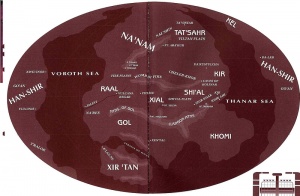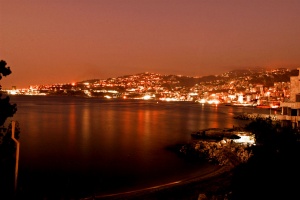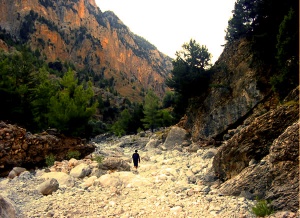More actions
| Line 58: | Line 58: | ||
Having determined that the rich province to the North could not be conquered by military might alone - or only at devastating cost - T'Velah hatched the plan to take the Kir matriarch's daughter and heir hostage. While certainly in keeping with the ancient Vulcan tradition of hostage-fostering, this deliberate gambit was intended to produce an heir who would be raised by T'Velah and as such answerable to her, while lending legitimacy to her claim to Kir. | Having determined that the rich province to the North could not be conquered by military might alone - or only at devastating cost - T'Velah hatched the plan to take the Kir matriarch's daughter and heir hostage. While certainly in keeping with the ancient Vulcan tradition of hostage-fostering, this deliberate gambit was intended to produce an heir who would be raised by T'Velah and as such answerable to her, while lending legitimacy to her claim to Kir. | ||
Faced with the challenge of leading a raid deep into enemy territory, the Warlord of Khomi opted for a maneuver this far deemed suicide - a crossing of the volcanic plains and unguarded passes beneath [[Tar'Hana]] with a small contingent of light [[Jarel]] cavalry. Water caches deposited by advance scouts over the course of two seasons allowed the troops to traverse the uninhabitable region with negligible losses, placing his strike force in an ideal position for the | Faced with the challenge of leading a raid deep into enemy territory, the Warlord of Khomi opted for a maneuver this far deemed suicide - a crossing of the volcanic plains and unguarded passes beneath [[Tar'Hana]] with a small contingent of light [[Jarel]] cavalry. Water caches deposited by advance scouts over the course of two seasons allowed the troops to traverse the uninhabitable region with negligible losses, placing his strike force in an ideal position near the foothills of Llangon. | ||
The raid was successful, owing as much to the Warlord's well trained advance scouts keeping track of their target's movements and enabling the general to choose a suitable ambush site, as to sheer brazenness. In a move still deemed a strategic masterpiece, the Warlord of Khomi coordinated a feint attack from the South with his own swift retreat through the Pass of Kov'van-kur, falling on the defending [[Kir]] troops from the rear and escaping with not only his prize but more than half of his strike force intact. | |||
Historians debate whether this nearly perfect timing in an age that had no long-distance communication was happenstance, strategic genius or plain dumb luck. Legends that the Warlord owned a trained [[Shavokh]] to carry messages might explain some of the uncanny sense of timing which the general displayed throughout his career, however no archaelogical evidence to support this legend has been found. | |||
In a move that is both considered an attempt to placate her increasingly difficult warlord and humiliate the despised rival, T'Velah gave the captured noble lady to her general with the explicit order to produce an heir as soon as possible. Some historical sources suggest a forced bonding, however Khomi regional lore maintains that acknowledging such a marriage would have not only elevated the Warlord's standing, but in fact placed him in a position to claim the name of Kir's High House for himself. While the exact circumstances of the Warlord's relationship with the lady who in most texts is referred to only as 'Ş`yal-arÿa' (Saraya) or T'sai Kush'hath (Lady Wild-one, likely a derogatory reference to [[Sas-a-Shar]] blood rather than descriptive of her character) remain a matter of debate, it is generally acknowledged that the matter evolved into a rather torrid love affair. | |||
==== Uprising of the Houses Minor ==== | |||
Romanticized versions of the upheavals that would eventually lead to T'Velah's downfall and near extinction of her house cast the Warlord and his unlikely bride at the center of events. Having indeed produced a daughter with blood-claims to [[Kir]], Saraya was unwilling to cede the child to the rival matriarch and either by virtue of the general's feelings or political ambition (most likely however a combination of both) secured his support in leading a revolt. | |||
It is likely that despite the Warlord's army and his popularity along the [[Thanar Sea|Thanar]] coast the uprising would have been quelled, if not several minor houses smarting under T'Velah's often tyrannical rule had taken the opportunity to declare their fealty to the High House rescinded. Some sources point to a reversed version of events, namely that the Warlord was dipatched to subdue the revolt and instead chose to join it. | |||
Revision as of 10:59, 8 October 2015

A peninsula on the southeasternmost part of the Na'Nam Continent, Khomi province shares a border with Kir and Shi'al to the north and Gol to the west. Except for the Llangon Mountains, the savannah-like plains to the west and a small fertile strip along the coast, Khomi primarily consists of flat and barren hardpan; cracked and canyoned by regular tectonic activity. The region's wealth consists almost exclusively in its large mineral deposits and the trade conducted by its coastal cities. However, one should also note that the wines produced in the hills near Te’Rashar are prized for their unique flavors and exquisite quality and the city's university is second only to the great learning centers of Shi'Kahr.
History

Due to its wealth in ores and minerals on a planet where weapons were always in demand and supplies short, Khomi province has for millennia been saved from extensive warfare only due to its unique geological position. Protected by mountains to the north and west and a jagged coast most everywhere else, the ruling clans held the peninsula unchallenged until rougly the 39th century of the Vulcan calendar (2700 BCE by terran standard).
With the inevitable advances in warfare and the rise of powerful clans in Gol and Shi'al, the borders began to shift and skirmishes increased. However, it was not until an eruption of Mount Tar'Hana and a series of earthquakes opened new passes in the forbidding mountains that a short lived alliance of western clans succeeded in laying claim to several mines and plundering coastal cities.
The following decades were marked by near constant war as the indigenous houses sought to regain sovereignty but were hampered by shortness of supplies and raw materials while the conquering forces were plagued by the unpredictability of their superiors who demanded the mining operations to remain in full force while troops were overextended and materiel only arrived sporadically.
As a result of nearly a century of scorched earth warfare and constant raids, the population began to doubt their leaders' ability to restore their lands and the province erupted into full civil war.
It was not until another dozen years later that one of the occupying forces suffered a devastating defeat during a campaign to invade Kir and subsequently had to withdraw their forces, giving the battered and war-torn houses of Khomi a chance to regain valuable strongholds and mines. However, with their economy in shambles and wide-spread starvation resulting low birth rates, the clans were forced into unfavorable alliances and much valuable land that had been hard fought for was bargained away to keep the old rulers in power.
Rise and Fall of T'Velah
Born to one of the most powerful coastal clans of Khomi, T'Velah was destined to become matriarch simply by virtue of cunning and utter ruthlessness. Having spent her youth experiencing the devastating conquest of her ancestral home Ari'Kel and the poverty resulting from it, she was one of the youngest matriarchs ever to ascend to power after successfully assasinating the rival clan's nobility and seducing the captain in command of their guards. For over a century, the fortress and city of Ari'Kel remained firmly in T'Velah's hands while the population dwindled and if not for a fateful meeting during the last years of the civil war, T'Velah might have remained no more than a footnote in ancient scrolls.

Historical records clearly indicate that the young lieutenant who caught the matriarch's attention with his successful defense of vital farmsteads with a mere handful of starving troops was of minor, impoverished nobility and would never have been considered for a high position in the clan if not for his strategic genius and uncanny ability to inspire loyalty in troops that were weary from endless wars, underfed and ill equipped. The lieutenant's dazzling rise to the matriarch's warlord who remained undefeated throughout his life is the subject of many legends on Vulcan, just as the stoires of his campaigns remain required reading at the Institute of Defensive Arts.
After merely three decades, the province's coastline and few fertile areas were firmly in T'Velah's hand and her victorious warlord was rewarded with the little port town of Te'Rashar. Some sources insist the holding was also an attempt to remove the notorious male from T'Velah's court and the noble ladies who were only too eager to show favor to the matriarch's general, upsetting fragile alliances and carefully maintained bloodlines.
Ironically it was to the small but old and wealthy clan to the North that T'Velah's eyes turned first when she decided to expand her realm, and conquest of the famous orchards and rich underground springs of Kir was to become a lifelong obsession.
The Warlord and Vulcan's first Standing Army
For all its warfare, Vulcan has never been good at organizing it. Until the Age of Exploration and the inception of High Command there had never been standing armies beyond the obligatory handful of personal guards - in fact, the concept, had it ever occurred, would have been considered outrageously expensive. Where would you keep a host of soldiers, and more importantly, where would you get food and water for them? A leader with a cause would raise what forces she or he could, and if they were persuasive enough would have a larger force than the enemy. If you won, you carried home the spoils, or simply moved in and claimed the place for yourself while enslaving the defeated, absorbing them into your own clan, or putting them to the sword.
Among the few exceptions to this historical fact are the V'Ket (though one might argue whether an order of warrior-priests qualifies as an army) and the Warlord of Khomi.
While almost ridiculously small as standing armies go, the Warlord nonetheless maintained a pure fighting force by virtue of negotiating agreements with such farmsteads and trade centers as could afford to trade food for protection. After the ravages of the civil war, the offer was attractive enough for many to warrant the expenses.
With the Warlord's rise under T'Velah the troops of Khomi evolved into an army which the ancient Terran culture of Sparta would have recognized as a desert-bred offshoot in terms of warrior-ethics and relentless training.
Conquest and Trade
With the Warlord's army established as the basis for her power, T'Velah expanded her reach to the very borders of Kir, but while her general remained undefeated in every battle, a way to overcome the fortifications in the mountain passes eluded both of them. Hemmed in by the Thanar Sea to the East, the matriarch decided to challenge the clan of Fort Go'eyel located in the Northwest corner of Khomi and gateway to Gol to bring its rich mines and weapons forges under her control. In a campaign that lasted all of a tenday the Warlord achieved complete victory, razing the fort and plundering the settlements. What survivors were unwilling to swear fealty to the House Minor that T'Velah had deeded the region to were enslaved or killed. To this day Go'eyel is a synonym for utter devastation on Vulcan (a Vulcan engineer heard muttering about 'Go'eyel' is indicating that one may as well scuttle the ship and start from scratch as repairs seem a pointless endeavour).
One of the Warlord's lesser known but more long lasting achievments was the development of Te'Rashar into a lively port town doing brisk trade along Khomi's coast and attracting merchants from as far as Xir'Tan. While the city's rise to prominence as one of Khomi's centers of culture and trade should not occur until centuries after the Warlord's death, historians generally agree that the roots of this development can be found in the general's founding of a "free port" and granting special benefits to any artisan and craftsman willing to settle at Te'Rashar.
Challenging Kir

Having determined that the rich province to the North could not be conquered by military might alone - or only at devastating cost - T'Velah hatched the plan to take the Kir matriarch's daughter and heir hostage. While certainly in keeping with the ancient Vulcan tradition of hostage-fostering, this deliberate gambit was intended to produce an heir who would be raised by T'Velah and as such answerable to her, while lending legitimacy to her claim to Kir.
Faced with the challenge of leading a raid deep into enemy territory, the Warlord of Khomi opted for a maneuver this far deemed suicide - a crossing of the volcanic plains and unguarded passes beneath Tar'Hana with a small contingent of light Jarel cavalry. Water caches deposited by advance scouts over the course of two seasons allowed the troops to traverse the uninhabitable region with negligible losses, placing his strike force in an ideal position near the foothills of Llangon. The raid was successful, owing as much to the Warlord's well trained advance scouts keeping track of their target's movements and enabling the general to choose a suitable ambush site, as to sheer brazenness. In a move still deemed a strategic masterpiece, the Warlord of Khomi coordinated a feint attack from the South with his own swift retreat through the Pass of Kov'van-kur, falling on the defending Kir troops from the rear and escaping with not only his prize but more than half of his strike force intact.
Historians debate whether this nearly perfect timing in an age that had no long-distance communication was happenstance, strategic genius or plain dumb luck. Legends that the Warlord owned a trained Shavokh to carry messages might explain some of the uncanny sense of timing which the general displayed throughout his career, however no archaelogical evidence to support this legend has been found.
In a move that is both considered an attempt to placate her increasingly difficult warlord and humiliate the despised rival, T'Velah gave the captured noble lady to her general with the explicit order to produce an heir as soon as possible. Some historical sources suggest a forced bonding, however Khomi regional lore maintains that acknowledging such a marriage would have not only elevated the Warlord's standing, but in fact placed him in a position to claim the name of Kir's High House for himself. While the exact circumstances of the Warlord's relationship with the lady who in most texts is referred to only as 'Ş`yal-arÿa' (Saraya) or T'sai Kush'hath (Lady Wild-one, likely a derogatory reference to Sas-a-Shar blood rather than descriptive of her character) remain a matter of debate, it is generally acknowledged that the matter evolved into a rather torrid love affair.
Uprising of the Houses Minor
Romanticized versions of the upheavals that would eventually lead to T'Velah's downfall and near extinction of her house cast the Warlord and his unlikely bride at the center of events. Having indeed produced a daughter with blood-claims to Kir, Saraya was unwilling to cede the child to the rival matriarch and either by virtue of the general's feelings or political ambition (most likely however a combination of both) secured his support in leading a revolt.
It is likely that despite the Warlord's army and his popularity along the Thanar coast the uprising would have been quelled, if not several minor houses smarting under T'Velah's often tyrannical rule had taken the opportunity to declare their fealty to the High House rescinded. Some sources point to a reversed version of events, namely that the Warlord was dipatched to subdue the revolt and instead chose to join it.
Files uploading ...
